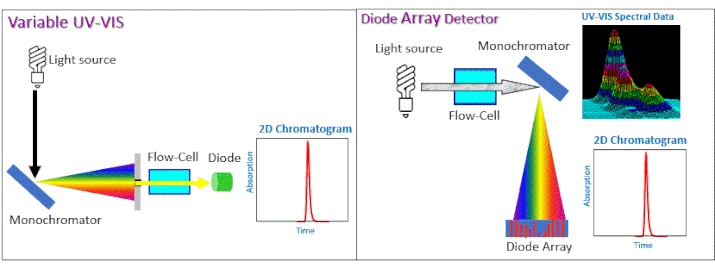| The topic of this article may not meet Misplaced Pages's general notability guideline. Please help to demonstrate the notability of the topic by citing reliable secondary sources that are independent of the topic and provide significant coverage of it beyond a mere trivial mention. If notability cannot be shown, the article is likely to be merged, redirected, or deleted. Find sources: "UV detectors" – news · newspapers · books · scholar · JSTOR (November 2019) (Learn how and when to remove this message) |
An ultraviolet detector (also known as UV detector or UV-Vis detector) is a type of non-destructive chromatography detector which measures the amount of ultraviolet or visible light absorbed by components of the mixture being eluted off the chromatography column. They are often used as detectors for high-performance liquid chromatography.
The vast majority of liquid chromatographic systems are equipped with ultraviolet (UV) absorption detectors. The most common UV-Vis detectors used are variable wavelength detectors (VWD), photo diode array detectors (PDA), and diode array detectors (DAD). Variable wavelength detectors decide in advance which wavelength is needed for the detection. Its absorbance as function of time is collected in a graphic format called a chromatogram.
As can be seen in Figure 1, these detectors have a light source, a dispersion element that is a diffraction grating or prism, a flow cell, to where the sample arrives directly from the chromatographic column, an optical bench of lenses and mirrors, and a diode that receives the light coming from the optical system and translates it into a signal proportional to light intensity. When the user selects a wavelength for the detector, the optical system rotates the grating or prism in the space, so that the desired wavelength passes through optical system, then the flow cell and reaches the diode. The UV/Vis detector then produces a chromatogram as a two-dimensional (2D) output. This output plots time on the x-axis and response in absorbance units (AU) on the y-axis. The chromatogram is then analyzed by integrating the peaks curves to get their area, then getting their retention time (RT) from the peak maximum to identify them, and then perform quantitative analysis, by comparing their area to those of samples whose concentrations are known, i.e, standards.
Diode Array UV-VIS Detectors
In recent years, diode array UV-Vis detectors have been increasingly used to collect entire spectra at any given moment of data collection. Diode array detectors (DADs) collect entire UV spectra at every point of the eluting peaks while operating as a multi-wavelength UV-Vis detector. This way they give additional information, which help understand more about the nature of the substances appearing in the chromatogram and allow their identification. DADs are the preferred detectors for HPLC method development because they facilitate better peak identification.

A schematic of the optical systems is shown in Figure 1. The variable UV-Vis absorbance detector's optical bench is showing how the flow cell is positioned after the optical system, including the monochromator, which typically has a physical slit and a moving grating, so it is illuminated by a selected wavelength, reaching a photo-diode. The bench of the diode array detector, however, is configured so that the flow cell is positioned before the optical parts, so that the beam containing the entire spectrum is passing through it. The optical parts consist also with a monochromator and a slit, but with a fixed grating, which disperses the light onto a diode array imaging element.
References
- L.C. Passos, Marieta; M.F.S. Saraiva, M. Lúcia (2019). "Detection in UV-visible spectrophotometry: Detectors, detection systems, and detection strategies". Measurement. 135: 896–904. doi:10.1016/j.measurement.2018.12.045. ISSN 0263-2241. S2CID 117622937.
- Wysocki, Jedrzej; Dong, Michael (2019). "Ultraviolet Detectors: Perspectives, Principles, and Practices". LCGC North America. LCGC North America-10-01-2019. 37 (10): 750–759.
- Meyer, Veronika (2010). Practical high-performance liquid chromatography (5th ed.). Chichester, U.K.: Wiley. ISBN 9780470688427. OCLC 613324719.
- Swartz, Michael (2010-07-13). "HPLC DETECTORS: A BRIEF REVIEW". Journal of Liquid Chromatography & Related Technologies. 33 (9–12): 1130–1150. doi:10.1080/10826076.2010.484356. ISSN 1082-6076.
- Dolan, John W.; Berry, Vern V. (June 1, 1984). "Optical Detectors, Part III: Variable-Wavelength UV Detectors" (PDF). Liquid Chromatography Troubleshooting. 2 (6): 439–442 – via Liquid Chromatography Troubleshooting Bible.
- George, S. A.; Maute, A. (1982). "A photodiode array detection system: Design concept and implementation". Chromatographia. 15 (7): 419–425. doi:10.1007/bf02261601. ISSN 0009-5893. S2CID 93087073.
This article related to chromatography is a stub. You can help Misplaced Pages by expanding it. |